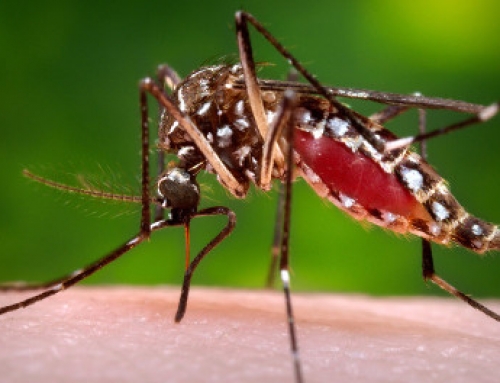Zika virus life cycle
The life cycle of ZIKV is similar to other known flaviviruses. Briefly, the E proteins are involved in the attachment of the virus to receptors on the host membrane. Subsequently, the virus gets internalised via endocytosis. The viral RNA is released into the cytoplasm following fusion of the viral and host membranes. The ssRNA is then translated, and the resulting polyprotein further gets cleaved into various structural and non-structural proteins (C, prM, E and NS proteins) [16].
Replication takes place on the ER surface. Transcription and replication of the dsDNA result in the formation of new viral mRNA and ssRNA, respectively. Following viral assembly at the ER, the virion budding utilises the host ESCRT (endosomal sorting complexes required for transport) machinery to transport to the Golgi apparatus. The prM protein is cleaved, and the virion is rendered mature. Finally, the mature virus exits the cell via exocytosis [16].

Fig 5: Viral Replication
Host Immune Response [14]
Following viral infection the host’s immune system recognises viral proteins and elicits an antiviral response. Previous studies on flaviviruses showed that both TLR3 and TLR7 (Toll-like receptors) are able to recognise molecules on these pathogens. Following recognition, the TLRs induce the host defence, initiating various signalling pathways, which lead to the production of type I Interferons (IFNs), inflammatory cytokines and chemokines. However, an in vitro study by Hamel et al on human fibroblast cell lines showed that ZIKV infection only enhanced TLR3, but not TLR7. The increased levels of TLR3 were accompanied with the production of IFN-α and IFN-β in the infected cells, a corresponding increase in the transcriptional levels of interferon regulatory factor 7 (IRF7), and the upregulation of expression of several IFN-stimulated genes. Simultaneously, there is an increase in the expression of two chemokines (CXCL10 and CXCL11), which are known to play crucial roles in adaptive as well as innate immunity. Upregulation of CCL5, another chemokine known for its antiviral activity, was also observed. As an antiviral host defence mechanism, the researchers found that both types I and II interferons are capable of inhibiting virus replication.
The Hamel et al study also showed that ZIKV infection triggered autophagy in the infected fibroblasts. Generally, autophagy-mediated degradation of viral proteins prevents the replication of the virus; however, some viruses, including ZIKV, utilise certain components of the autophagy cycle, and promote viral replication and dissemination. Electron microscopic studies also revealed membrane vesicles (70 – 100 nm) in close association with the ER; this indicates that ZIKV replication occurs intimately with the host cell membrane.
Conclusion
Considering the global emergence and pathogenic nature of ZIKV, further studies are needed to identify the underlying mechanisms and mode of action of this virus. This will help identify antiviral targets and devise therapies, to fight this globally expanding menace.
References
- Dick, G.W.A., Kitchen, S.F., Haddow, A.J. Zika virus. I. Isolations and serological specificity. Trans R Soc Trop Med Hyg 46: 509–520 (1952).
- Moore, D.L., Causey, O.R., Carey, D.E., Reddy, S., Cooke, A.R., Akinkugbe, F.M., David-West, T.S., Kemp, G.E. Arthropod-borne viral infections of man in Nigeria, 1964–1970. Ann Trop Med Parasitol 69:49–64 (1975).
- Olson, J.G., Ksiazek, T.G., Suhandiman, Triwibowo. Zika virus, a cause of fever in Central Java, Indonesia. Trans R Soc Trop Med Hyg 75:389–393 (1981).
- Duffy, M.R., Chen, T-H., Hancock, W.T., Powers, A.M., Kool, J.L., et al. Zika virus outbreak on Yap Island, Federated States of Micronesia. N Engl J Med 360: 2536–2543 (2009).
- Hayes, E. Zika Virus Outside Africa. CDC Emerging Infectious Diseases (2009).
- Chen, Lin H., Hamer, Davidson H. Zika Virus: Rapid Spread in the Western Hemisphere. Annals of Internal Medicine 164: 613 (2016).
- Musso, D., Nilles, E.J., Cao-Lormeau, V.-M. Rapid spread of emerging Zika virus in the Pacific area. Clinical Microbiology and Infection 20 (10): O595–6 (2014).
- CDC Zika: Transmission. S. Centers for Disease Control and Prevention. (15 April 2016).
- CDC Concludes Zika Causes Microcephaly and Other Birth Defects. (13 April 2016).
- Petersen L.R., Jamieson D.J., Powers A.M., and Honein M.A. Zika Virus. Engl J Med; 374:1552-63 (2016).
- Faye O., Freire C.C.M., Iamarino A., Faye O., de Oliveira J.V.C, et al. Molecular Evolution of Zika Virus during Its Emergence in the 20th Century. PLoS Negl Trop Dis 8(1): (2014)
- Clarke, B.D., Roby, J.A., Slonchak, A., Khromykh, A.A. Functional non-coding RNAs derived from the flavivirus 3′ untranslated region. Virus Res. 206:53-61 (Aug 3, 2015).
- Kostyuchenko, V.A., Lim, E.X.Y., Zhang, S., Fibriansah, G., Thiam-Seng Ng, Ooi J.S.G., Shi, J., Shee-Mei Lok. Structure of the thermally stable Zika virus. Nature Received 24 March 2016, Accepted 11 April 2016, Published online 19 April 2016 (2016)
- Hamel, R., Dejarnac, O., Wichit, S., Ekchariyawat, P., Neyret, A., Luplertlop, N., Perera-Lecoin, M., Surasombatpattana, P., Talignani, L., Thomas, F., Cao-Lormeau, V., Choumet, V., Briant, L., Desprès, P., Amara, A., Yssel, H., and Missé, D. Biology of Zika Virus Infection in Human Skin Cells. J Virol. Sep 1; 89(17): 8880–8896 (2015).
- Buckley, A., Gould, E. A. Detection of Virus-specific Antigen in the Nuclei or Nucleoli of Cells Infected with Zika or Langat Virus. Journal of General Virology 69 (8): 1913–1920 (1988).
- ViralZone: Zika virus (strain Mr 766). Retrieved April 10, 2016, from http://viralzone.expasy.org/all_by_species/6756.html (2016).




